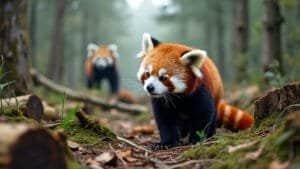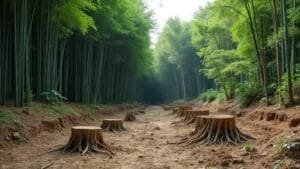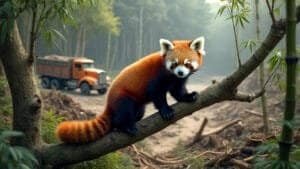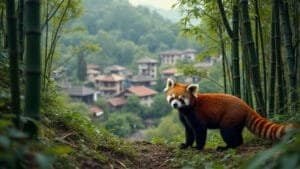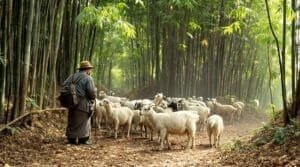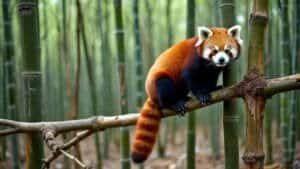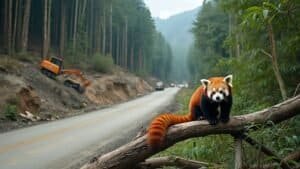Agricultural expansion is increasingly threatening red panda habitats across the Eastern Himalayas, where these elusive, endangered creatures reside. How does agricultural expansion encroach on red panda habitats? As human populations grow, forests are cleared for crop cultivation, livestock grazing, and infrastructure development—disrupting the delicate balance of red panda ecosystems
These activities fragment bamboo-rich forests, reduce food sources, and limit the movement necessary for breeding and survival. In regions like Nepal’s Panchthar-Ilam-Taplejung corridor, habitat degradation has reached alarming levels, pushing red pandas toward higher extinction risk
This article explores the impact of deforestation, grazing, and climate change on red panda populations, focusing on regional hotspots and long-term threats. It also highlights conservation strategies, including community-based initiatives and habitat restoration, aimed at reversing this trend. By examining the multifaceted effects of agriculture on these animals, we gain a clearer understanding of the urgent need for sustainable land use in red panda range areas
Agricultural Expansion and Red Panda Habitat Loss

As agricultural expansion spreads through the Eastern Himalayan regions, it directly undermines the survival of red pandas by degrading and fragmenting their natural habitats. These forests, rich in bamboo and biodiversity, are being converted into farmland and grazing areas, disrupting the delicate ecological niche red pandas depend on
Their diet, primarily consisting of bamboo, is becoming increasingly scarce due to human land-use activities. Moreover, the loss of continuous forest tracts limits their movement and mating potential, making populations more isolated and genetically vulnerable
Deforestation and Slash-and-Burn Practices
Deforestation is one of the most destructive outcomes of agricultural expansion for red panda habitats. In Nepal and northeastern India, forest lands are commonly cleared using slash-and-burn techniques—a practice where trees and vegetation are cut and burned to create temporary farming plots. This method not only reduces forest cover but also leads to long-term soil degradation, making the land unsuitable for regeneration
Red pandas rely heavily on undisturbed forest canopies that host mature trees for nesting and ample bamboo undergrowth for food. Once these forests are cleared, red pandas are forced into fragmented patches, often close to human settlements, which increases their exposure to threats like poaching and dog attacks
The loss of tree canopies also affects the microclimate necessary for bamboo growth. Bamboo thrives in cool, moist environments—conditions provided by dense forest cover. As deforestation removes these protective layers, bamboo becomes less abundant and more susceptible to disease and climate fluctuations. A 2021 study published in Biological Conservation highlights that habitat loss due to shifting agriculture in the Eastern Himalayas is one of the primary factors contributing to red panda population declines
Livestock Grazing and Bamboo Depletion
Livestock grazing adds another layer of stress to red panda habitats. In the Himalayan regions, it’s common for herders to lead their cattle, sheep, and goats into forested areas in search of fodder. Unfortunately, these grazing practices degrade bamboo stands in two major ways: direct consumption and trampling. Young bamboo shoots, which form the bulk of a red panda’s diet, are particularly vulnerable. When livestock feed on these tender shoots, it not only reduces immediate food availability but also prevents the regeneration of bamboo stands
Additionally, livestock often outcompete red pandas for space within the same forest areas. The continuous movement and presence of herds can disrupt red panda nesting behavior, leading to increased stress and lower reproductive success. The effects of grazing are particularly evident in Nepal’s PIT corridor, where bamboo availability has sharply declined in areas with intensive livestock activity
According to the Ohio State University’s open-access publication Science Bites, research conducted on red panda habitats confirms that livestock grazing significantly reduces the number and density of bamboo clumps, directly correlating with reduced red panda sightings in those zones
Conversion of Forests to Agricultural Land
One of the most visible and measurable impacts of agricultural expansion is the direct conversion of forest land into farmland. In rural Himalayan communities, agricultural fields are often carved out of steep, forested slopes, further destabilizing ecosystems already sensitive to erosion and weather extremes. This land conversion reduces the size of continuous habitats and isolates red panda populations into increasingly smaller zones, making them more vulnerable to inbreeding and local extinction
The lack of ecological corridors between these isolated forest patches means that red pandas cannot easily migrate in search of new habitats or mates. This fragmentation also limits their ability to escape from natural disasters like landslides or human disturbances. According to Earth.Org, habitat connectivity is critical for the long-term survival of red pandas, and agricultural land conversion is one of the main factors undermining that connectivity
For more detailed insights into the causes and consequences of habitat degradation, this Earth.Org article on red pandas provides an extensive overview of the pressures they face from human encroachment and environmental changes
Regional Impact of Agriculture on Red Panda Territories

Across the red panda’s range in the Eastern Himalayas, regional differences in topography, population density, and land-use practices result in varying degrees of habitat encroachment. However, the underlying threat remains consistent: expanding human activities are fragmenting and degrading once-contiguous bamboo forests
This fragmentation not only limits the red panda’s ability to forage and reproduce but also impairs genetic flow between populations. Regions in Nepal, India, Bhutan, and southwestern China are facing distinct but interconnected challenges as agricultural needs outpace conservation measures
Critical Zones: Nepal, India, Bhutan, and China
In Nepal, approximately 70% of red panda habitats fall outside protected areas, exposing them to unregulated agricultural expansion and deforestation. The country’s eastern region, especially the Panchthar-Ilam-Taplejung (PIT) corridor, is one of the most heavily impacted by human settlement and land-use change
Studies by the Red Panda Network indicate that the PIT corridor contains over 400 fragmented forest patches, many surrounded by expanding agricultural zones. As villagers clear forests for cardamom cultivation and livestock grazing, red pandas lose not only food sources but also the tree cavities essential for nesting
In India, red pandas are primarily found in the states of Sikkim, Arunachal Pradesh, and parts of northern West Bengal. Here, habitat loss is often compounded by road construction and small-scale farming. Arunachal Pradesh, which harbors one of the largest contiguous red panda populations in India, is facing increasing pressure from jhum cultivation (a form of shifting agriculture). This method contributes to significant deforestation and increases the frequency of forest fires, further reducing bamboo coverage
Bhutan presents a unique case where conservation has historically been embedded in national policy. Despite this, the push for food self-sufficiency and rising population pressures in rural areas have led to localized deforestation. Red panda habitats in Bhutan are especially sensitive to microclimatic changes brought on by both land-use and climate factors
In southwestern China, particularly in Sichuan and Yunnan provinces, red panda populations are impacted by infrastructure development alongside traditional agriculture. Habitat patches here are more isolated, and conservation efforts are increasingly focused on creating ecological corridors and enhancing bamboo regeneration
The Panchthar-Ilam-Taplejung Corridor
The PIT corridor is one of the most vital and simultaneously vulnerable habitats for red pandas. Located in eastern Nepal, this region is home to a large segment of Nepal’s red panda population. However, intensive agricultural development, especially for crops like cardamom, potatoes, and maize, has steadily encroached into forested zones. The demand for more arable land has led many local farmers to expand uphill into what were once dense, bamboo-rich forests
According to field reports by the Red Panda Network, local communities in this area often rely on forest resources for fuelwood and fodder, placing additional stress on the ecosystem. The result is a highly fragmented habitat where red pandas must navigate between isolated patches, often crossing farmlands or human settlements that expose them to predators and domestic animals
The PIT Red Panda Protected Forest initiative is working to counter these impacts through reforestation and corridor linkage projects, but the pace of agricultural expansion continues to outstrip conservation gains
Fragmentation of Red Panda Habitats
Habitat fragmentation is one of the most pressing consequences of agricultural encroachment. In a healthy forest ecosystem, red pandas travel between feeding and nesting sites using the forest canopy and understory as cover. But as these habitats become chopped into smaller segments by farms, roads, and settlements, red pandas face increased isolation. This has severe ecological implications: small, disconnected populations are more vulnerable to genetic bottlenecks, disease outbreaks, and environmental fluctuations
Moreover, fragmented habitats are harder to monitor and protect. Conservation efforts become logistically more complex and less effective in landscapes interspersed with human activity. In areas like northeastern India and parts of Nepal, fragmentation has also led to behavioral shifts in red pandas, with increased reports of them venturing closer to human settlements in search of food or shelter—heightening the risk of poaching, dog attacks, and disease transmission
A complementary resource that delves into the fragmentation caused by grazing and deforestation in red panda habitats is available in this Ohio State Science Bites chapter, offering detailed data on grazing effects and ecological consequences
Conservation Responses to Agricultural Threats

Efforts to protect red panda habitats from the encroachment of agricultural expansion are growing more sophisticated and collaborative. Conservation organizations, local governments, and community members are working together to balance ecological preservation with the socio-economic needs of local populations
Through reforestation, community-based conservation, protected area designations, and targeted policy interventions, there is a concerted effort to halt and reverse the decline of red panda habitats across their native range. These strategies aim not only to restore habitat but also to create sustainable systems that discourage destructive land-use practices
Community-Based Forest Conservation Programs
Community involvement has become a cornerstone of red panda conservation. Initiatives such as the Red Panda Network’s Forest Guardian program in Nepal empower local individuals to act as stewards of the environment. These trained community members conduct patrols, monitor red panda populations, and educate their neighbors about sustainable resource use. By fostering local pride and providing employment, these programs reduce dependence on forest exploitation for income or food
Forest Guardians also help identify illegal logging, unsustainable grazing, and land encroachments. Their presence acts as a deterrent to habitat destruction while building grassroots support for conservation. Moreover, the program includes educational workshops and eco-tourism opportunities that generate income for communities, offering alternatives to farming and livestock grazing in red panda habitats
These community-led efforts are often more effective and culturally attuned than top-down conservation policies, making them essential for long-term success
Reforestation and Habitat Restoration Efforts
Reforestation plays a key role in mitigating the effects of agricultural expansion. Many organizations now focus on restoring degraded areas with native plant species, especially those that support bamboo regeneration. In Nepal and northeastern India, reforestation projects have begun in high-priority red panda habitats, including former agricultural lands no longer in use. These efforts are designed to reconnect fragmented forest patches, thereby enabling red pandas to travel safely between feeding and nesting sites
The use of native trees and specific bamboo species ensures ecological compatibility and supports faster habitat recovery. In several cases, communities are engaged in these restoration projects, with incentives provided through carbon offset programs or direct payments for ecosystem services. For example, in the PIT corridor, habitat restoration has included planting multiple bamboo species to replicate the dietary diversity that red pandas need throughout the year
Scientific support for these restoration projects comes from ecological models and GIS-based landscape planning that prioritize areas for maximum biodiversity return. This data-driven approach ensures that limited conservation resources are directed where they can have the most significant impact
Policy and Protected Area Implementation
On a broader scale, national and regional governments are working to implement and enforce conservation policies that safeguard red panda habitats from unchecked agricultural development. In Nepal, protected area boundaries have been expanded, and ecological corridors have been designated to allow red panda movement across fragmented landscapes. The Red Panda Network has collaborated with local governments to establish the PIT Red Panda Protected Forest, the world’s first protected area dedicated specifically to red pandas
In India, red pandas are listed under Schedule I of the Wildlife Protection Act, granting them the highest level of legal protection. Additionally, conservation plans at the state level include measures to regulate land use in buffer zones around key red panda habitats. Bhutan’s Gross National Happiness policy framework includes environmental conservation as a core pillar, which has helped preserve large tracts of forest that are home to red pandas
China has invested heavily in national park systems that consolidate fragmented reserves into large, contiguous conservation landscapes. The Giant Panda National Park, while named for its more famous relative, also encompasses critical red panda territories in Sichuan and Yunnan, contributing indirectly to their protection
To explore a broader view of endangered species protection and red panda conservation trends, visit this informative Earth.Org article, which outlines various global conservation efforts and policy challenges


